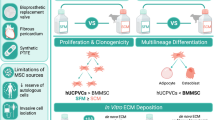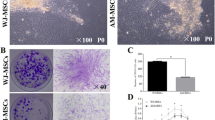Abstract
There is increasing scientific evidence that human umbilical cord cells are a valuable source of adult stem cells that can be used for various implications including regenerative medicine and tissue engineering. The review describes the role of progenitor cells (mesenchymal, endothelial, prenatal) for the use in cardiovascular tissue engineering, i.e., the formation of large vessels and heart valves from umbilical cord cells.
Currently used replacements in cardiovascular surgery are made of foreign materials with well known drawbacks such as thrombo-embolic complications, infection, loss of functional and biological properties, and others. Especially in the field of replacements in congenital cardiac defects, there would be a need of materials which have the advantage of optimal biological and mechanical properties. In the case of human umbilical cord cells, autologous cells can be used by minimally invasive procedures. The cells have excellent growth capacities and form a neo-matrix with excellent mechanical properties. For optimal growth and modeling, scaffolds are required with high biocompatibility and biodegradability, which allow cell attachment, ingrowth, and organization. Nutrients and waste must be easily transported and cells should be in entire contact with host's body. Finally, regenerated materials can be fully incorporated and the scaffold is completely replaced. Besides these cell and scaffold requirements, feto-maternal conditions and risk factors concerning deriving stem cells are of major interest. There are still many open questions concerning whether and how maternal conditions such as infection (viral or bacterial) or gestational age of the newborn influence stem cell harvesting and quality. If these cells will be used for the construction of replacement materials, it is clear that very strict criteria and protocols be introduced enabling the promising step from isolated cells to a therapeutic device such as a new heart valve. It is hoped that it will be only a question of time until human umbilical cord cells will be used frequently as the source of cardiovascular tissues among others in the clinical setting of treating congenital heart defects.
Similar content being viewed by others
References
Fauza D. Best Practice Clin Obstet Gynaecol 2004;18:877–891.
Korbling M, Robinson S, Estrov Z. Cytotherapy 2005; 7(3):258–261.
Maver J, Sem Thorac Cardiovasc Surg 1995;7(130–132).
Schoen FJ LR. J Biomed Mater Res 1999;47:439–465.
Hoerstrup SP, Sodian R, Sperling JS et al. Tissue Eng 2000b; 6:75–79.
Zund G, Hoerstrup SP, Schoeberlein A, et al. Eur J Cardiothorac Surg 1998;13:160–164.
Shinoka T, Ma PX, Shum-Tim D, et al. Circulation 1996;94 (9 Suppl):164–168.
Shinoka T, Shum-Tim D, Ma PX, et al. J Thorac Cardiovasc Surg 1998;115:536–546.
Horstrup S, Kadner A, Breymann C. Ann Thor Surg 2002;74(1):46–52.
Kadner A, Hoerstrup S, Tracy J, et al. Ann Thorac Surg 2002;74:S1422-S1428.
Kadner A, Zund G, Maurus C, et al. Eur J Cardio-Thorac Surg 2004;25:635–641.
Schmidt D, Breymann C, Weber A, et al. Ann Thorac Surg 2004;78:2094–2098.
Schmidt D, Mol A, Neuenschwander S, et al. Eur J Cardio-Thorac Surg 2005;27:795–800.
Schmidt D, Mol A, Breymann C, et al. Circulation 2006;114:1125–1131.
Sanatloya J, Leon JD. J Soc Gynecological Invest 2005;12(2):237A.
Solves P, Perales A, Moraga R. Acta Haematol 2005;113(4):241–246.
Author information
Authors and Affiliations
Corresponding author
Rights and permissions
About this article
Cite this article
Breymann, C., Schmidt, D. & Hoerstrup, S.P. Umbilical cord cells as a source of cardiovascular tissue engineering. Stem Cell Rev 2, 87–92 (2006). https://doi.org/10.1007/s12015-006-0014-y
Issue Date:
DOI: https://doi.org/10.1007/s12015-006-0014-y




